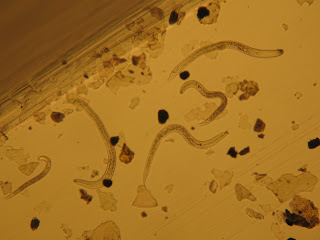I previously talked about how we sample and how we extract the nematodes, rotifers, tardigrades, and other small animals from a soil sample.
The next step is to examine the sample under a microscope. I explained the physical process of counting in my post about the lab, especially in the long caption under the picture of our microscopes. We scroll through the sample in a special sample counting dish and use a counting machine to keep track of things. We identify all of the nematodes by species, sex or stage in life cycle (male, female, or juvenile. Juvenile nematodes from the species we see don't have visible sex organs so we count all of them as juvenile), and living or dead. For tardigrades, rotifers, and everything else, we just identify them generally (tardigrade, rotifer, or "other" which usually means protozoan) and we only count the living specimens.
 |
| A female Scottnema lindsayae. You can see the indentation of the vulva pretty clearly |
 |
| A juvenile Scottnema lindsayae. No reproductive structures are seen. |
 |
| Main body of a Plectus murrayi juvenile. No reproductive structures are seen. |
 |
| Same Plectus as above except you can clearly see the distinctive tail characteristic of a Plectus |
 |
| A male (you can't tell that it's a male from this picture) Eudorylaimus antarcticus. Adults like this guy are so huge! It is impossible to fit the whole thing in one picture and have it be in focus! |
My video of an Antarctic tardigrade
My video of a collection of Scottnema lindsayae
So that's the stuff that we normally see! We see tons of Scottnema in the dry soils. When we sample closer to the streams or lakes, the diversity increases and we start to see a variety of these other animals too (and the numbers of Scottnema either drop low or disappear). In a plentiful sample, we can see 1000 nematodes. In a normal sample, we'll see a couple hundred. A few samples have absolutely nothing! It is still amazing to me that we find so many microscopic animals in such a desolate location. When we're sampling, it looks so dry and inhospitable that I can't imagine life to exist there.

Jeremy
ReplyDeleteI am very surprised at these counts in Antarctica.
What are the corresponding counts for a more moderate climate in good soil?
How do they survive the constant frozen conditions of the winter?
Since they are so durable I'm guessing they can be transported on the feet of birds, on your shoes, the helicopter landing gear, etc. So are the same species found throughout the world?
Thanks for the posts - wonderful stuff.
Neil
Yeah, the soils can be fairly high in nematodes, especially considering that this is from only 100 grams of soil. Soil from temperate regions can be 3000-4000 for the same extraction methods.
ReplyDeleteThese animals survive the winter through freeze-protection proteins and through dessication. They can dry up then come back to life once water returns! There's an article about this ability here http://news.byu.edu/archive09-Feb-antarctica.aspx
All of the nematodes that we find here in Antarctica are native and have yet to be found anywhere else. Some of the tardigrades are only found in Antarctica while some of them have a worldwide distribution. I'm not sure about the rotifers though. It is possible for them to be transported through a variety of methods. However, once we arrive in New Zealand, we have to clean off our boots. We are encouraged to also clean our boots before and after returning to the field.
I don't know if these nematodes would thrive in a different climate though. They are pretty adapted to the conditions here and there seem to be disadvantages to the specialization required for them to survive. For example, we find Scottnema by the hundreds in the dry soils on the valley sides. In wet soils, their numbers can drop to 20 or less. The idea is that Eudorylaimus and Plectus can thrive in the moist soils and outcompetes the hardy Scottnema. I would suspect that something similar would happen in a temperate climate with these Antarctic nematodes being driven to extinction by the nematodes more adapted to the area. That's the point of some of the experiments we are running-- how will the nematodes respond to increased temperature and increased moisture expected from climate change?